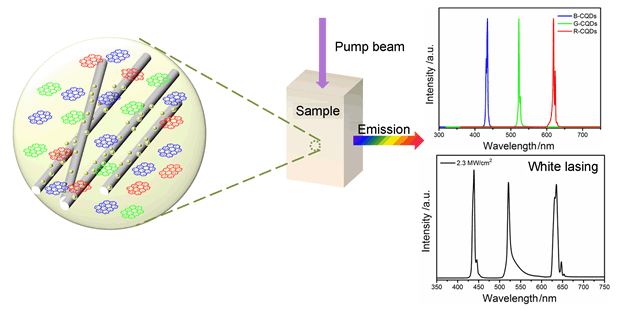摘要/Abstract

以本征态发光的高量子产率的碳量子点为激光增益介质,Au-Ag双金属多孔纳米线为散射颗粒,在纳秒激光的脉冲下,首次实现了基于碳量子点的全色随机激光.其中,蓝、绿、红三基色的发射半峰宽分别为2.5、1.9、2.3 nm,阈值分别为0.27、0.21、0.58 MW/cm2.激光照射60 min后,随机激光体系依然能保持良好的稳定性.将蓝、绿、红三色碳量子点以一定比例混合后,在高于阈值的泵浦功率下,首次实现了基于碳量子点的白光激光,为下一代的激光显示技术提供了新的可能.
关键词: 碳量子点, 本征态发光, 随机激光, 全色激光, 白光激光
The emerging fluorescent carbon quantum dots (CQDs) have shown enormous potentials in optoelectronic applications owing to their outstanding characteristics, such as tunable stable fluorescence emission, low cost, and environment-friendliness. However, the fluorescence of most reported CQDs is dominated by surface defects, which are in general energy dissipative, hard to support lasing emission. We have previously reported the bandgap emission CQDs from blue to red with a quantum yield (QY) over 50%, which is the highest value reported for bandgap emission CQDs. The bandgap transitions in CQDs were further confirmed by size-dependent optical properties through tansmission electron microscopy (TEM), which show uniform distribution nanoparticles with averge sizes of about 1.95, 2.41, 5.0 nm for blue, green and red CQDs, and their typical high-resolution TEM (HRTEM) images further indicates that most of the CQDs exhibit uniform atomic arrangements with high degree of crystallinity. By taking advantage of the high QY of CQDs, monochrome CQDs-based random lasing with low excitation threshold have been realized by using Au-Ag bimetallic porous nanowires as scatterers for the first time. The Au-Ag bimetallic porous nanowires possess a rough surface with Au nanoparticles and abundant nanogaps, leading to the extremely broadband surface plasmonic resonance peaks over the whole visible spectral range, which is benefit for efficient random lasing. The thresholds of the monochrome CQDs-based random lasers reached about 0.27, 0.21, 0.58 MW/cm2 for blue, green and red, respectively. The full width at half maximum (FWHM) of the monochrome CQDs-based random lasers reached about 2.5, 1.9, 2.3 nm for blue, green and red, which is even comparable to the well-developed semiconductor QDs-based random lasers. The obtained random lasers show substantial stable emission color, which is of great significance for lasing display and lighting technology. Furthermore, white lasing with a CIE coordinate at (0.32, 0.33) was first demonstrated by combining red, green, blue fluorescent CQDs. This work does serve the purpose of understanding and providing significant opportunities for further improvements of CQDs-based lasers.
Key words: carbon quantum dots, bandgap emission, random lasing, full-color, white laser
PDF全文下载地址:
点我下载PDF
